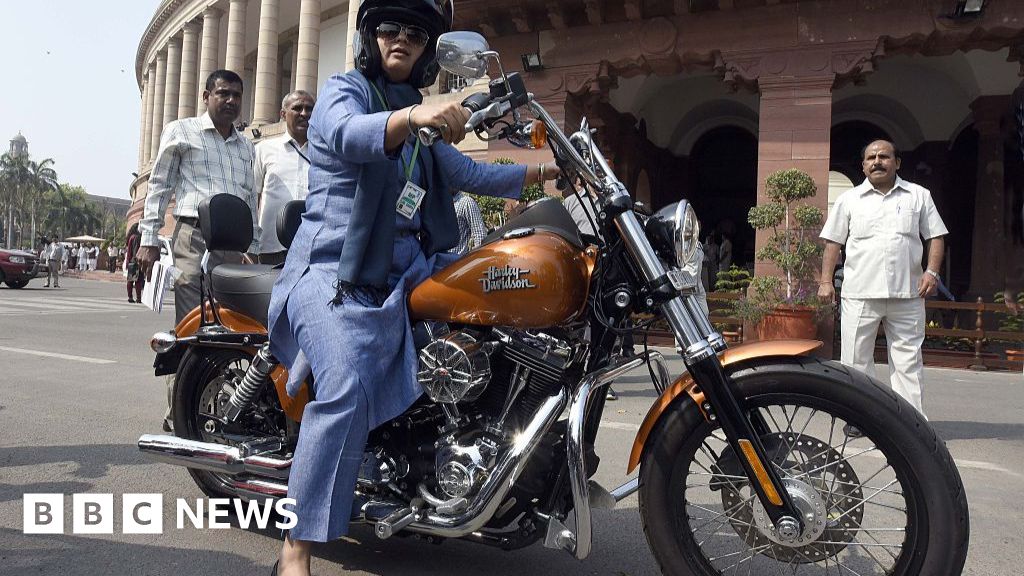Last week India further slashed import duties on motorcycles, cutting tariffs on heavyweight bikes with engines above 1,600cc from 50% to 30% and smaller ones from 50% to 40%.
A pre-emptive move designed to further smoothen the entry of Harley Davidsons into India – and, Delhi hopes, ward off any threat of tariffs. US motorcycle exports to India were worth $3m last year.
Donald Trump has marked his return to the White House by brandishing trade measures against America’s neighbours and allies as well as its big rival China.
India hopes it is ahead of the game – but will its tariff cuts satisfy Trump, or is trade action still on the table?
“Canada and Mexico are literally two arms of the US. If he has acted against them, he could easily act against India too,” says Ajay Srivastava, founder of the Delhi-based think tank Global Trade Research Institute (GTRI).
In their phone conversation late last month, the US president pressed Prime Minister Narendra Modi to buy more US arms and for there to be a fairer trade balance, keeping the pressure on.
And during his first term, Trump fixated on India’s steep tariffs. He repeatedly slammed the then 100% duty on Harleys as “unacceptable”, making it a rallying point in his crusade against what he saw as unfair trade practices.
In the past he repeatedly branded India a “tariff king” and a “big abuser” of trade ties.
India enjoys a trade surplus with the US, its top trading partner. Bilateral trade crossed $190bn (£150bn) in 2023. Merchandise exports to US have surged 40% to $123bn since 2018, while services trade grew 22% to reach $66bn. Meanwhile, US exports to India stood at $70bn.
But beyond bikes, India has zeroed out import taxes on satellite ground installations, benefiting US exporters who supplied $92m worth in 2023.
Tariffs on synthetic flavouring essences dropped from 100% to 20% ($21m in US exports last year), while duties on fish hydrolysate for aquatic feed fell from 15% to 5% ($35m in US exports in 2024). India also scrapped tariffs on select waste and scrap items, a category where US exports amounted to $2.5bn last year.
Top US exports to India in 2023 included crude oil and petroleum products ($14bn), LNG, coal, medical devices, scientific instruments, scrap metals, turbojets, computers and almonds.
“While Trump has criticised India’s tariff policies, the latest reductions signal a policy shift that could enhance US exports across various sectors,” says Mr Srivastava.
“With key tariff cuts on technology, automobiles, industrial and waste imports, India appears to be taking steps towards facilitating trade even as the global trade environment remains tense.”
Meanwhile India’s exports span a diverse range – from textiles, pharmaceuticals and engineering goods to petroleum oils, machinery and cut diamonds. It also ships smartphones, auto parts, shrimp, gold jewellery, footwear and iron and steel, making it a key player in global trade.
“This diverse range of products reflects India’s broad export base and its strong trade relationship with the US,” says Mr Srivastava.
India was once among the world’s most protectionist economies. In the 1970s, American political scientist Joseph Grieco described it as having one of the “most restrictive, cumbersome… regimes regulating foreign direct investments”.
This inward-looking approach led to a steady decline in India’s export share of global trade, from 2.42% in 1948 to just 0.51% by 1991. As Aseema Sinha, author of Globalizing India: How Global Rules and Markets are Shaping India’s Rise to Power, observed, this period was marked by “a self-driven industrialisation drive, export pessimism, and suspicion of global alliances”.
India finally opened up in the 1990s and 2000s, cutting average tariffs from 80% in 1990 to 13% in 2008.
But after Modi launched his “Make in India” policy to boost manufacturing in India tariffs have climbed again to about 18% – higher than those set by other Asian nations such as China, South Korea, Indonesia and Thailand.
Trade expert Biswajit Dhar believes India is now a prime target under Trump’s “America First” policy, which seeks reciprocal action against high import taxes and reassesses trade with large US deficits.
Agricultural market access remains a sticking point for the US, he says.
India dropped retaliatory tariffs on US-made almonds, apples, chickpeas, lentils and walnuts in 2023, but Trump will likely demand more. However, India may hold firm given domestic political sensitivity around farming.
“This is where we will drive a hard bargain, and problems could arise,” cautions Mr Dhar.
That said, India’s strategic ties with the US – as a Quad member countering China – could help ease friction. India’s willingness to accept the deportation of undocumented Indian migrants in the US without pushing back has also sent a positive signal, Mr Dhar notes.
Experts also point to Modi’s warm personal rapport with Trump as an advantage. Some clarity will come when the Indian prime minister visits the White House – this month, according to some reports – at Trump’s invitation.






